|
The
Prophet's Hair
Summary
Genre
Magical
Realism
Theme
Qur'an
Symbols
-- The Prophet Hair
Ironies
Questions
References
Summary
¡§The
Prophet¡¦s Hair¡¨ is based on story of the theft of a relic containing
a hair of the Prophet Muhammad. The tale is a fantastic account of the
miraculous but disastrous events befalling all those who come into
contact with it. The stolen relic is found by a moneylender, Hashim.
Instead of returning it to the mosque from which it was taken, he keeps
it. Under its influence, this previously secular Muslim becomes orthodox
to the point of extremism and hurt his family by adopting it.
His son, Atta, tries to take the hair back to Mosque, but at the last
minute he finds out that the hair is no longer with him because there is
a hole in his pocket (2849 L6). Then Huma comes up with another plan,
and decides that it will have to be stolen by hiring a thief, ¡¥Sheikh
Sín¡¦, who takes the hair amid a scene of carnage. However, she
ends up with a disaster.
At the end of story, Hashim accidentally kills his own daughter, but he
does not realize what he has done until he turns the light on. Finally,
the thief is hunted and shot by the police, but his four crippled sons
and blind wife have miraculously been cured by their contact with the
relic.
Rushdie describes Hashim¡¦s family as an insecure and frightened
family. The story is concerned with an iconic object, the hair, and its
relocation from a holy place, the shrine, to the profane space of the
outside world, then to a secret hiding place in the moneylender¡¦s
locked study, and finally back to the shrine again.
Form: Storytelling
Narration: It is a flashback style of narration that starts from
Atta¡¦s search for a professional burglar.
Genre
1. Parable
2. Magical Realism
Parable: to check human desire & follow natural cause
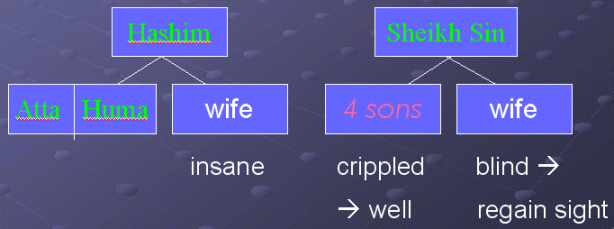
Magical
Realism
| Hashim¡¦s
change: |
guilty? |
|
consider
himself to be a superior? |
|
affected
by hair? |
History
1.
painting: 1925, a German art critic, Franz Roh
(a new post-expressionistic form¡Xsurrealistic
vision)
2.
literature: 1940s, a Cuban, Alejo Carpentier
(¡§lo real maravilloso¡¨¡Xmarvelous reality)
3. Gabriel
Garcia Marquez¡¦ One Hundred Years of
Solitude & John Fowels¡¦ French Lieutenant¡¦s
Woman.
Feature
realistic
+ fantastic + mysterious
+ enigmatic + mythological¡K elements
2
conflicting perspectives:
1)
based on a rational view of reality
2) acceptance of the supernatural as mundane
reality
set in a normal, modern world
with authentic descriptions of humans and society
http://dmoz.org/Arts/Literature/World_Literature/Latin_American/Magic_Realism/
http://www.southern.ohiou.edu/realmagic/default.html
Theme
|
Anti-Islam?
¡¨By
articulating a grievance, I could help, or so I hoped, to
build bridges of understanding.¡¨ (Imaginary Homelands, by
Rushdie)
To mock at idol worship
---> religion: a powerful tool in the hands of rulers
---> deities or objects:
Dh Tyuo (ªÙ§Q¤l)
, Matsu palanquin (¯«Ãâ)
---> superstition, extremity
|
Qur'an
7-204
Al-A'raf (The Heights)

Waitha
quria alquranu faistamiAAoo lahu waansitoo laAAallakum turhamoona
7:204 When
the Qur'an is read, listen to it with attention, and hold your peace:
that ye may receive Mercy.
112-1
Al-Ikhlas (The Purity)

Qul huwa
Allahu ahadun
112:1 Say:
He is Allah, the One and Only
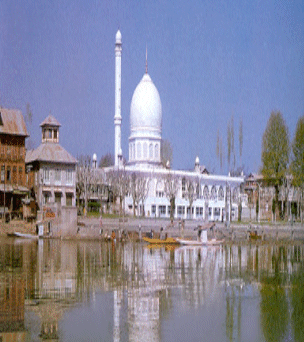 |
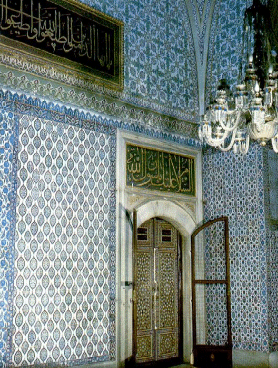 |
|
Hazratbal,
Mosque |
Entrance
of the Sacred Relic Chambers |
¡@
|
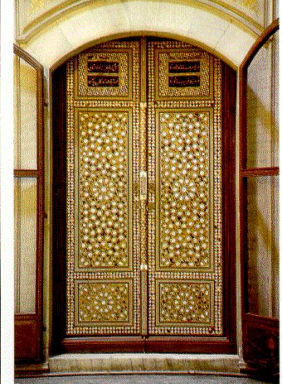
|
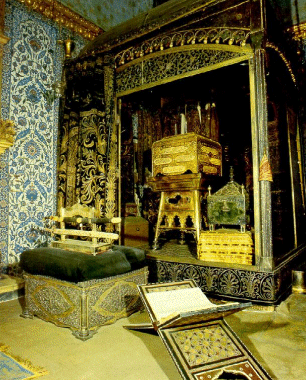
|
|
Entrance
Door of the Sacred Relic Chambers |
Interior
View of the Sacred Relic Chambers |
¡@
|
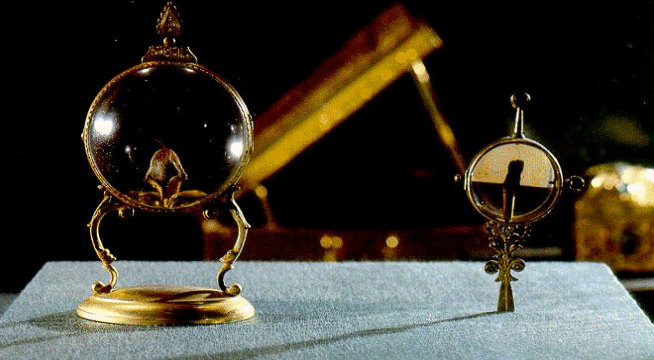
|
|
Some hairs
from the beard �of the Prophet Muhammad |
Symbols
-- The Prophet Hair
Through the journey
of different places that the relic of the Prophet Muhammad has been
relocated (from the shrine, the outside world, Hashim¡¦s sanctum, and
then back to the shrine again), the meaning of the hair is being changed
as well.
Hair as
a religious relic
The hair is a famous relic which is regarded as a symbol of the sacred
image of the Prophet Muhammad. It was restored in its shrine at
Hazratbal mosque. However, the loss of the relic has caused the riots,
the political ramifications and the changes in the two families. (2846
par 5~6)
Hair as
a secular object
The relocation of the relic changed the hair's meaning. However, it's
not the object itself which changes the meaning, but human beings.
Hashim, the moneylender, changes the relic from the religious value to a
secular object (2846 last par). Even though the hair's meaning has been
changed, its mysterious magic still exists. Influenced by the
misappropriated relic, Hashim leads the family into carnage (massacre).
Hair as
a human heart
The hair reveals the desire of human being by possessing the great
rarity of beauty. It may also reveal the truth inside human beings.
While having dinner with his family, Hashim gushed the awful truth in
his mind¡Xhow he thought about his marriage, his children, and revealed
the existence of a mistress. He, finally, ¡§got many things off his
chest.¡¨ (2847 par 5~end)
Prophet's Hair and Its Reverence
The hair displays on a certain day once a year. People touch or kiss the
box and rub hands on their faces in order to get blessing.
The hair has been formally authenticated; however, is it the right way
to show love of the prophet? People do not need a part of his body to
show their love, do they? The proper way is to follow his guidance and
implement his Sunnah. Like Hashim, who possesses the hair, instead of
bringing luck, he leads the family to a disaster.
Ironies
Irony1
What Hashim says and what he does is opposite. He likes to say
that he sets great store by living honorably in the world.
Hashim pointed out that while he
was not a godly man he set great store by ¡¥living honourably
in the world¡¦. (2845, par 2 from the bottom)
But actually Hashim isn¡¦t worthy of honor because he treats
cruelly those debtors who are unable to pay the latest
installment of interest.
That afternoon, a trembling debtor
arrived at the house to confess his inability to pay the latest
installment of interested owned, and made the mistake of
reminding Hashim, in somewhat blustering fashion, of the
Qur¡¦an¡¦s strictures against usury. The moneylender flew into
a rage and attacked the fellow with one of his large collection
of bulliwhip¡K..
(2848 par 3- 4, 2849)
From the two paragraphs, we can see how Hashim treats his
debtors. When one debtor reminds him that usury is against the
Qur¡¦an¡¦s stricture, Hashim flies into a rage and attacks the
fellow. By the fourth afternoon, he hires two thugs to extract
the unpaid money from two of his broken clients.
He can do anything
unscrupulously to get the money or achieve his goal. (2848, last
par)
It's clear that the moneylender's business is violent and
threatening. He is faithful to Islam externally, but he still
runs usury business which is strictly forbidden by Qur¡¦an.
When he gets the hair, instead of returning it, he keeps it to
his desk. He persuades himself the Prophet would not have
approved of this relic-worship because the Prophet abhors the
idea of being deified. That¡¦s his way to make his statement
consistent.
He can do anything unscrupulously
to get the money or achieve his goal. (2848, last par)
It's clear that the moneylender's business is violent and
threatening. He is faithful to Islam externally, but he still
runs usury business which is strictly forbidden by Qur¡¦an.
When he gets the hair, instead of returning it, he keeps it to
his desk. He persuades himself the Prophet would
not have approved of this relic-worship because the Prophet
abhors the idea of being deified. That¡¦s his way to make his
statement consistent.
'And after all,¡¦ Hashim told himself, the Prophet would have
disapproved mightily of this relic-worship. He abhorred the idea
of being deified! So, by keeping this hair from its distracted
devotes, I perform¡Xdo I not?¡Xa finer service than I would by
returning it! Naturally, I don¡¦t want it for its religious
value¡KI¡¦m a man of the world. I see it purely as a secular
object of great rarity and blinding beauty. In short, it¡¦s the
silver vial I desire more than the hair. (2846-47)
The truth is he desires the silver vial more than the hair. The
prophet¡¦s hair is a secular object rarity and blinding beauty
which belongs to one of his collector¡¦s mania.
His keeping the hair violates Muslim law, and profanes the
religious value. Under the hair¡¦s great influence, Hashim
changes his life style and becomes weird. When the inversion
comes, he begins to pray ¡§for the first time of his life¡¨
and forces his family members to do as the same.
At five o¡¦clock the next morning
the moneylender forced his family to rise, wash and say their
prayers. From then on, he began to pray five times daily for the
first time in his life, and his wife and children were obliged
to do likewise. (2847-48)
Also, he orders his family and servants to read Qur¡¦an, which
is ¡§the only volume left untouched before¡¨ in their house.
He ordered each member of his
family to read passages from this book for at least two hours
per day. (2848 par 1, L5~6)
It seems that Hashim becomes a religious man because of reading
Qur¡¦an, but it¡¦s not true. He is pious on his behavior not
from the bottom of his heart. He starts to behave abnormally
when he gets the hair. Besides threatening his debtors, he yells
at his family and abuses them. (2849 par 5)
Anyhow, the moneylender¡¦s occupation is not compatible with
the society of Muslim. In a word, Hashim's reverence for
religious worship is represented as hypocritical.
Irony2
Huma tries to save her
family, but the plan failed out of Atta¡¦s voice. As the thief
comes to Hashim¡¦s house, Atta cries out ¡§Thief! Thief!
Thief!¡¨ oddly for three times.
(2851 par 3, L5)
Is it coincidence or the
power of the magic hair? It just happens and Huma can¡¦t stop
the disaster.
Irony3
The prophet¡¦s hair has
the numinous and supernatural power which handles the fate of
Hashim¡¦s family and Shiekh¡¦s in the story. Or we can say
their destiny is influenced by the hair and the natural cause.
Is the hair so
powerful?
People would usually overextend and reinforce its mysterious
strength, even if it¡¦s only a trivial thing. Here, Rushdie
uses the juxtaposition of the rich Hashim¡¦s house and the poor
Sheikh¡¦s to set a contrast. The glassy contentment of the
household is to be shattered which is a foreshadowing of the
coming of their tragedy. Compared with Hashim¡¦s luxurious
house, Sheilkh¡¦s family live in all darkness (blackness).
All around him in his study was the
evidence of his collector¡¦s mania¡K (2846 par 2 from the
bottom)
¡K.blackness.
(2844 par 4, L 6 ¡§Shiekh¡¦s needy world¡K¡¨ )
¡Kinto the light-repellent gullies of the most wretched and
disreputable part of the city.
(2852 par 2, L6~7)
Atta and Huma have a wealthy life; ironically, Shiekh¡¦s four
sons are crippled by their father to make their living.
For, with a parent¡¦s
absolutist love, he had made sure they were all provided with a
lifelong source of high income by crippling them at birth, so
that, as they dragged themselves around the city, they earned
excellent money in the begging business.
(2850 par 3 from the bottom, L5~8 )
¡Kthat they were all sound of limb and strong of wind, as whole
as they might have been if their father had not thought to smash
their legs in the first hours of their lives.
(2852 par 2 from the bottom, L4~6 )
Is the miracle
fortunate to them?
Probably it is, but not all the persons involved think so. When
the miracle happens to Sin¡¦s four sons, they are furious
because they lose their power to earn their living after having
the sound bodies.
They were, all four of them, very properly furious, because the
miracle had reduced their earning powers by 75 per cent, at the
most conservative estimate; so they were ruined men. (2852 par 2
from the bottom, L6~9)
Irony4
Is the hair fortunate
or unfortunate?
The hair symbolizes the sacred image of the Prophet of Mohammed,
and it¡¦s an ironic object in this story. Its relocation is
from the shrine (a holy place), to the outside world (the
profane place), and to the moneylender¡¦s locked study (the
profane place), back to the shrine (a holy place) again. The
relic should be put into the shrine, it is profaned and violates
its holy nature when it is stolen. Hashim¡¦s family¡¦s
reverence for icon is hypocritical, and they are subjected to
the general carnage. The force of the hair seems to have been
replaced its meaning through its transplantation.
Many people suppose that they would be blessed if they hold the
icon, but it¡¦s not right. No matter the hair has the might or
not, it deeply influences human being¡¦s heart and behavior.
Beyond human desire, people would like to hold the icon and hope
they could have good luck. Hence they would forget the genuine
importance easily and to be lost in their desire. This is a
parable which teaches us to break with iconoclasm and
superstition.
All in all, the goal of religion is to help people lead a better
life not to believe it blindly.
|
Questions
Why did the relic play such a significant part in Hashim's life? After
Hashim found the relic, what drove him crazy and abusive?
What are the elements of realism in this story? Of magic?
The Satanic Verses was condemned by many Muslims as a blasphemous
portrait of Islam and the prophet Mohammed. How are the various Muslims
in the story depicted, and do those depictions add up to a blasphemous
portrait of Islam?
References
Websites
http://islamicity.com/dialogue/Q519.HTM
http://pages.intnet.mu/islam/quran_mp3.htm
http://www.altmuslim.com/world_comments.php?id=627_0_22_0_C
http://www.ee.bilkent.edu.tr/~history/religious.html
http://www.wwnorton.com/nrl/english/NAEL/NAEL72/Period3Twentieth/CourseSessions3/PostModernRushdie.html
¡@
|
![]()







